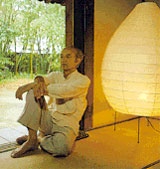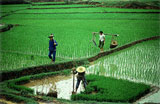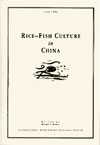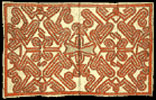

Search the Journey to Forever website – click HERE

Navigation
|
Mulberry trees
A hundred years ago half the population in parts of south China was working in the booming silk industry. The land was covered with mulberry trees producing leaves to feed the silkworms.

Painting a mulberry bark Tapa cloth with traditional dyes in Papua New Guinea
|
This was an integrated and sustainable farming system, coupled with duck and fish production: the silkworm waste and duck droppings produced food for the fish in the ponds; once a year the fish were sold, the ponds drained and the fish waste and silt was used to fertilise the mulberry trees. Production rates were very high. (See below -- Silk, rice and fish)
Like most trees -- perhaps even all trees -- mulberry trees (Morus alba) have many further uses. In "Tree Crops: A Permanent Agriculture" (ISBN 0-933280-44-0, 1950), American researcher J. Russell Smith writes that mulberry trees provide high-quality harvest-free feed for pigs and chickens.

Mulberry leaves and fruit at the Journey to Forever organic garden
|
He quotes the case of a small farmer in North Carolina who kept pigs and claimed that one-third their weight was due to the mulberries falling from his trees -- about 625 lb of pork to an acre of "rather thin, sandy land with little care and no cultivation".
Russell Smith says mulberry trees are cheap, very easy to propagate, easy to transplant, they grow rapidly, start fruiting almost immediately, have a long fruiting season and don't need harvesting. The leaves can also be eaten as a vegetable and make a nutritious feed for dairy cattle.
Fruit yields are estimated at 4-14 tons per hectare. James A. Duke, in "Handbook of Energy Crops" (1983, unpublished), sees the mulberry tree as a source of energy:

Cleaning boiled mulberry tree bark to make shoji paper in Japan
|

Making paper, one sheet at a time
|

Papering the bamboo frame of an Akari lamp
|
"Those of us who have seen solid coats [of mulberry fruits] on the ground realize that there is a lot of sugar there that could be converted to alcohol." He also cites work in South Korea on producing high yields of ethanol from mulberry tree sawdust by acid hydrolosis.
Mulberry is also a widely used traditional folk remedy, used for "aphtha, armache, asthma, bronchitis, bugbite, cachexia, cold, constipation, cough, debility, diarrhea, dropsy, dyspepsia, edema, epilepsy, fever, headache, hyperglycemia, hypertension, inflammation, insomnia, melancholy, menorrhagia, snakebite, sore throat, stomatitis, tumors, vertigo, and wounds" (Duke and Wain, 1981).
Mulberry twigs are used for making baskets, the sticks as beanpoles, and the wood for fuelwood, sporting goods (it's springy, like ash) and fine furniture. In Japan, the traditional "chashaku" green tea scoop used in semi-formal tea ceremonies is made of mulberry wood. If it's not mulberry then it's only an informal one. (Formal chashaku are supposed to be ivory.)
Japanese sculptor Isamu Noguchi used "shoji" paper made by hand from boiled mulberry tree bark for his famous Akari lamps, now regarded as pure modernist sculpture (there's a permanent exhibition of them in the Museum of Modern Art in New York). Noguchi was inspired by the traditional rice-paper lamps used by Japanese fishermen for night fishing.

Isamu Noguchi with an Akari lamp
|
Mulberry bark is also used for paper in Europe, and in Polynesia it is used to make a fabric called Tapa cloth -- an ancient craft that is now helping to save rainforests in the region.
New Guinea has the largest remaining tropical forest in the Asia/Pacific region, but it is under severe threat from industrial logging.

Maisin teenager in Papua New Guinea
|
The Maisin people of Papua New Guinea have rejected proposals from the big timber companies to sell their one million acres of ancestral rainforest. Instead, they have resolved to build their livelihoods from more sustainable practices, such as making and selling their traditional Tapa cloths, made from mulberry trees grown in their gardens. Green groups are helping the Maisin to find a worldwide market for their products.

Maisin Tapa cloth panels
|
Mulberries have been adapted to a very wide variety of local conditions. Japan has about 700 different types. The trees can grow from cool temperate to warm tropical regions, from dry to moist areas, from sea-level to as high as 3,300 metres.
Mulberry trees grow well in containers -- we planted a mulberry cutting in an old bathtub in our organic garden at our headquarters at the Beach House on Lantau Island. It was fruiting within weeks. Mulberries are attractive trees, and the fruit is delicious.
Silk, rice and fish
 "Chinese Methods for Integrating Fish Culture with Crop and Livestock Farming" -- Integration of fish, livestock, and crop production in China has been refined for over 2,000 years. The system recycles resources, reduces organic pollution (livestock and poultry manure are good organic fertilizers for fish farming), and combines fish farming with mulberry cultivation for raising silkworms. The silkworm pupae are used as fish feed, and the worm faeces and wastewater from silk processing as pond fertilizers. Pond silt is used as fertilizer for fodder crops, which can in turn be used to feed livestock, poultry, and fish. "Chinese Methods for Integrating Fish Culture with Crop and Livestock Farming" -- Integration of fish, livestock, and crop production in China has been refined for over 2,000 years. The system recycles resources, reduces organic pollution (livestock and poultry manure are good organic fertilizers for fish farming), and combines fish farming with mulberry cultivation for raising silkworms. The silkworm pupae are used as fish feed, and the worm faeces and wastewater from silk processing as pond fertilizers. Pond silt is used as fertilizer for fodder crops, which can in turn be used to feed livestock, poultry, and fish.
http://archive.idrc.ca/nayudamma/fishcul_30e.html
 "Rice-Fish Culture in China" edited by Kenneth T. MacKay, IDRC, 1995, 240 pp, ISBN 0-88936-776-0 "Rice-Fish Culture in China" edited by Kenneth T. MacKay, IDRC, 1995, 240 pp, ISBN 0-88936-776-0
Raising fish in rice paddies brings to farmers in Asia an important source of protein, as well as extra income. Biological and ecological aspects of rice-fish culture, and the economic and social dimensions. Full text online:
http://www.idrc.ca/books/776.html
Related projects
Sisters of silk -- Hong Kong's Chinese Amahs
Silkworms in a shoebox
Kids' crazes
Mulberry tree resources on the Web
Mulberry tree (Morus alba) seeds from SBE Seed Co. -- 50 seeds US$1.95
http://www.seedman.com/fruit.htm
All about mulberry trees, from the California Rare Fruit Growers, Inc.
http://www.crfg.org/pubs/ff/mulberry.html
Even more about mulberries from James A. Duke's "Handbook of Energy Crops" (1983, unpublished), at the Center for New Crops & Plant Products, Purdue University, Indiana: Uses, Folk Medicine, Chemistry, Description, Germplasm, Distribution, Ecology, Cultivation, Harvesting, Yields and Economics, Energy, Biotic Factors, References.
http://www.hort.purdue.edu/newcrop/duke_energy/Morus_alba.html
Yet more about mulberry trees, from "A Modern Herbal", by Mrs. M. Grieve, originally published 1931. Interesting on history of mulberries, especially in Ancient Greece and Rome, and England: King James 1's famous edict promoting the widespread planting of mulberries to encourage English silk production -- only he got the wrong tree! Hence the lack of English silk. Shakespeare's famous mulberry tree, the sad fate thereof.
http://www.botanical.com/botanical/mgmh/m/mulcom62.html
Akari Light Sculptures at the Isamu Noguchi Garden Museum Store:
http://shop.store.yahoo.com/akaristore/akari.html
The Isamu Noguchi Garden Museum
http://www.noguchi.org/
"The Akari Light Sculpture of Isamu Noguchi" -- article by Bruce Altshuler
http://www.noguchi.org/baakari.html

Maisin Tapa cloth
|
Painting a Sustainable Future: Maisin Art and Rainforest Conservation in Papua New Guinea -- Image Gallery, Maisin Tapa, Background, at CorpWatch.
http://www.corpwatch.org/trac/
gallery/maisin/index.html
"Jumping Lines: Maisin Art and Rainforest Conservation", Background Paper on the Maisin of Papua New Guinea, John Barker, University of British Columbia
http://www.bampfa.berkeley.edu/exhibits/jumpline/JBessay.html
Larry Rinder reports on a journey to the Maisin villages.
http://www.virtualschool.edu/mon/SocialConstruction/
MaisinTapa/HotWiredJourneyTapa.html
|

![]()








 "Chinese Methods for Integrating Fish Culture with Crop and Livestock Farming" -- Integration of fish, livestock, and crop production in China has been refined for over 2,000 years. The system recycles resources, reduces organic pollution (livestock and poultry manure are good organic fertilizers for fish farming), and combines fish farming with mulberry cultivation for raising silkworms. The silkworm pupae are used as fish feed, and the worm faeces and wastewater from silk processing as pond fertilizers. Pond silt is used as fertilizer for fodder crops, which can in turn be used to feed livestock, poultry, and fish.
"Chinese Methods for Integrating Fish Culture with Crop and Livestock Farming" -- Integration of fish, livestock, and crop production in China has been refined for over 2,000 years. The system recycles resources, reduces organic pollution (livestock and poultry manure are good organic fertilizers for fish farming), and combines fish farming with mulberry cultivation for raising silkworms. The silkworm pupae are used as fish feed, and the worm faeces and wastewater from silk processing as pond fertilizers. Pond silt is used as fertilizer for fodder crops, which can in turn be used to feed livestock, poultry, and fish. "Rice-Fish Culture in China" edited by Kenneth T. MacKay, IDRC, 1995, 240 pp, ISBN 0-88936-776-0
"Rice-Fish Culture in China" edited by Kenneth T. MacKay, IDRC, 1995, 240 pp, ISBN 0-88936-776-0